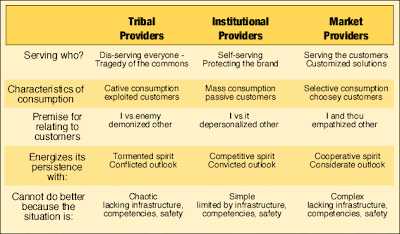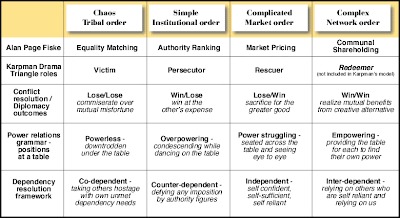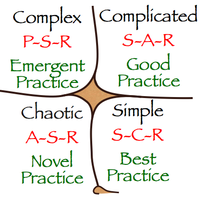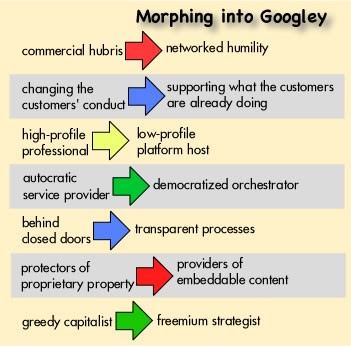
When markets come on the scene, tribal and institutional forms do not disappear. What David Ronfeldt calls a "Triform society" emerges from the combined presence of all three kinds of order. A SIMPLE situation where order could be maintained by stable institutions, now becomes a COMPLICATED situation. Institutions with monopoly control over their prices and quality now face rivals offering competing value propositions. Customers who previously accepted what was offered consistently now expect choices, better service, customized solutions and responsiveness to their particular contexts. Advertising that previously promoted brand names must now get in the customer's heads to appeal to their own diverse preferences, perceptions and memberships.
This analysis can obviously be applied to the global, domestic or regional economy. In later posts in this series, I'll apply it to particular markets and institutional contexts like secondary and university educational systems. This analysis follows on the prior two for Chaotic-Tribal order and Simple-Institutional order. There remains the fourth network order which provides an even more comprehensive context for these three orders I'm exploring today. (You can view a full size chart by right clicking on the one above to open it in a new tab)
Serving who?
The complications of a diverse bunch of customers is a welcome opportunity for any market order. It responds to the challenge to better serve a more varied demographic, segmentation and range of niches. Market order breaks out of the box of "take it when it's offered", "watch it when it's shown", "accept the same version as everyone else". Customers feel understood, supported in their own endeavors and well-served by the ways a market order responds to the complexity. This contrasts with institutional order which responds as if the customers are simply the same, wanting whatever preserves the self-serving institution's profitability, market share, brand name and product upgrades. This also differs dramatically from tribal responses to perceived chaos which do a potentially harmful dis-service to customers, depriving them of real value, useful experiences, enduring impacts and genuine satisfaction.
Characteristics of consumption
A market order explodes with a diversity of offerings that meet the needs of small niches, interest groups and specialized contexts. The customers are very selective, particular and informed. Consumer advocacy components have raised the bar on what customers expect, look for and reject as inadequate. Responsiveness to customers remains too varied to ever formulate best practices. The only possibility is good practices following considerable analysis of the complicated situations, options, rivals and customer segments. This contrasts with institutional responses that mass produce for mass consumption as if the buyers are passive consumers desperately filling their cupboards, attics, garages and storage lockers with excess stuff. The market response also differs from tribal response to an unwitting, captive market that can be exploited with exorbitant prices, shoddy quality, sporadic service and outright scams.
Premise for relating to customers
Market responses get the customer understood by listening, learning, exploring and discovering. The market order empathizes with what the customer is trying to accomplish with whatever they are buying. The context of the customer's use, their premises for perceiving value and the pitfalls they fall into when using what they bought -- all get revealed by relating sincerely and respectfully. This contrasts with institutions that get blinded by their success to think "we already know what we're doing" and "what the customers do with our products is none of our business". This also differs from tribal responses that perceive customers as "wanting something for nothing", "quick to change suppliers" and "too cheap to appreciate higher quality offerings".
Energizes its persistence with:
Market responses feed on the how customers respond to being cared for, served and understood. They respond in kind and make it easier for the provider to refine, diversify and follow through on what they offer. The spirit of cooperation permeates the interactions with customers who see the immediate benefits of playing along with the service provider. This contrasts with the competitive spirit of institutional rivals which seek larger market share to beat their rivals while acting on the conviction that they product is questionably superior. This also defies the conflicted spirit of tribal providers who get torn between acting greedy, wicked and deceitful and keeping up appearances of reliability, trustworthiness and integrity.
Cannot do better because the situation is:
Market order cannot do any better than it already does because their situation is so COMPLICATED. There are so many different customers seeking varied services, customized products and disaggregated delivery systems. This contrasts with institutions that get trapped by their success, structures, legacy practices, policies and tenured employees which makes "business as usual" so SIMPLE to maintain. This also differs from any tribal inability to improve when they're constantly set back by the lack of stability, safety, infrastructure, and competencies to handle the CHAOTIC situation.










